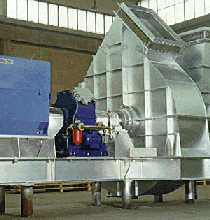bhaskar5150
Petroleum
In our DCU plant, we have 2 nos of FD fans (identical) for supplying combustion air to the burners with the following data :
Flow : 10.896 m3/sec, Static pressure :4700 pa (479 MMWC), Rated power : 61.25 KW
Temp : 35C, RPM : 980, Motor rating : 75KW. Impeller type : Backward curved.
Each fan has a IGV at suction for flow control & discharge damper is full close or full open & has a full close command on individual motor trip. Heater has a trip on low combustion air pressure in individual ducts (4 passes) to the burners.(25MMWC trip pressure against a normal of 34MMWC in individual passes).
Fan-A has a inherent problem of coupling failure (more than 3 times, last one in Jun'16).It is a practice here to run both fans in parallel since its commissioning. Present flow is around 6.6 M3/sec & static pressure is 410 MMWC. This is done by throttling the IGVs of both the fans.(Control is single command for both IGVs) In all previous cases, the coupling bolts & shims break getting uncoupled with the motor but motor still running (doesn't trip), therefore doesn't closes the discharge damper & flow from Fan-B goes to Fan-A & reverse rotates the fan. (This is obvious & only a after effect of coupling seizure). Then, discharge damper of Fan-A is closed manually.
Another important fact is that normally after every start-up, one fan (Fan-B in last 3 cases) is started first as the flow requirement is less initially & after a certain time interval the 2nd fan (Fan-A in last 3 cases) is started and IGVs of both the fans are adjusted accordingly to get the desired flow & static pressure.
From above, it can be concluded the Fan-A starts against a back pressure (created by the static pressure of Fan-B). Is it because of this that the Fan-A never recovers under parallel operation, operates on the left of the peak pressure of the fan curve and goes under stall. Due to this flow reversal in fan-A, coupling shims & bolts breaks as they are weakest components in that line. Also, the stalling zone is not defined by the manufacturer in the individual fan curve.
Also, there is no vibration issues reported & so the factors such as misalignment, bend shaft, eccentricity, unbalance may be ruled out.
If above is the cause, how to know & confirm it.
We are finding it very difficult to access the parallel performance of the fans and have no idea how the combined curve would behave under the present operating conditions.
Any advice/suggestion to get a permanent solution to this problem.
Thanks in advance.
Flow : 10.896 m3/sec, Static pressure :4700 pa (479 MMWC), Rated power : 61.25 KW
Temp : 35C, RPM : 980, Motor rating : 75KW. Impeller type : Backward curved.
Each fan has a IGV at suction for flow control & discharge damper is full close or full open & has a full close command on individual motor trip. Heater has a trip on low combustion air pressure in individual ducts (4 passes) to the burners.(25MMWC trip pressure against a normal of 34MMWC in individual passes).
Fan-A has a inherent problem of coupling failure (more than 3 times, last one in Jun'16).It is a practice here to run both fans in parallel since its commissioning. Present flow is around 6.6 M3/sec & static pressure is 410 MMWC. This is done by throttling the IGVs of both the fans.(Control is single command for both IGVs) In all previous cases, the coupling bolts & shims break getting uncoupled with the motor but motor still running (doesn't trip), therefore doesn't closes the discharge damper & flow from Fan-B goes to Fan-A & reverse rotates the fan. (This is obvious & only a after effect of coupling seizure). Then, discharge damper of Fan-A is closed manually.
Another important fact is that normally after every start-up, one fan (Fan-B in last 3 cases) is started first as the flow requirement is less initially & after a certain time interval the 2nd fan (Fan-A in last 3 cases) is started and IGVs of both the fans are adjusted accordingly to get the desired flow & static pressure.
From above, it can be concluded the Fan-A starts against a back pressure (created by the static pressure of Fan-B). Is it because of this that the Fan-A never recovers under parallel operation, operates on the left of the peak pressure of the fan curve and goes under stall. Due to this flow reversal in fan-A, coupling shims & bolts breaks as they are weakest components in that line. Also, the stalling zone is not defined by the manufacturer in the individual fan curve.
Also, there is no vibration issues reported & so the factors such as misalignment, bend shaft, eccentricity, unbalance may be ruled out.
If above is the cause, how to know & confirm it.
We are finding it very difficult to access the parallel performance of the fans and have no idea how the combined curve would behave under the present operating conditions.
Any advice/suggestion to get a permanent solution to this problem.
Thanks in advance.

